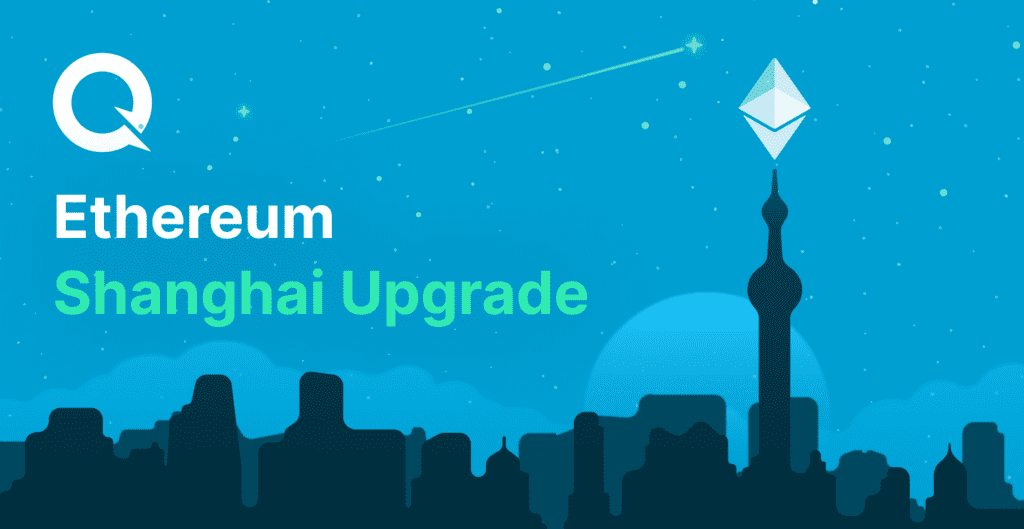The Ethereum Shanghai Upgrade marks a pivotal moment in the history of the Ethereum network, as it represents a significant milestone in the ongoing effort to enhance the scalability and efficiency of the platform.

With the rapid growth of the Ethereum ecosystem in recent years, it has become increasingly clear that the existing infrastructure was not designed to handle the scale and complexity of the demands placed upon it. As such, the Ethereum Shanghai Upgrade has been designed to address these limitations head-on, by introducing a range of innovative new features and enhancements that are specifically tailored to meet the needs of the modern blockchain landscape. From improved consensus mechanisms to more efficient transaction processing and enhanced security protocols, the Ethereum Shanghai Upgrade is poised to revolutionize the way that people interact with the Ethereum network, paving the way for a brighter, more decentralized future.
What Is the Ethereum Shanghai Upgrade?
Ethereum Shanghai Upgrade is a major upgrade to the Ethereum network, which was implemented through a series of Ethereum Improvement Proposals (EIPs) in October 2021. The upgrade is named after the city of Shanghai, where the Ethereum Foundation held its annual Devcon conference in 2019.
The main objective of the upgrade was to improve the network’s efficiency, security, and sustainability by implementing a number of EIPs that address various issues faced by the Ethereum ecosystem. These improvements were achieved by optimizing gas costs, improving the network’s transaction throughput, and enhancing its overall functionality.
Some of the key EIPs included in the Shanghai upgrade include EIP-1559, which aimed to improve the network’s fee market by introducing a base fee that is burned instead of being given to miners as a fee; EIP-3198, which introduced an opcode to make smart contract interactions more efficient; and EIP-3529, which implemented a reduction in the gas cost of certain operations to make the network more affordable and accessible.
Understanding the Ethereum Shanghai Upgrade

It includes a number of Ethereum Improvement Proposals (EIPs) aimed at improving the network’s efficiency, security, and sustainability.
One of the most significant EIPs included in the upgrade is EIP-1559, which aims to improve the network’s fee market. Prior to this upgrade, Ethereum users would have to bid against each other to have their transactions included in a block, with the highest bidder winning. This could result in high transaction fees during periods of high network congestion.
EIP-1559 introduces a base fee for transactions that is adjusted based on the level of network congestion. The base fee is burned, meaning it is removed from circulation, which reduces the overall supply of Ethereum and may contribute to the cryptocurrency’s deflationary nature. EIP-1559 includes a mechanism for users to tip miners to prioritize their transactions.
Another key EIP included in the upgrade is EIP-3198, which introduces a new opcode that allows for more efficient smart contract interactions. This can help reduce the gas cost associated with certain transactions and make the network more affordable for users.
Finally, EIP-3529 reduces the gas cost of certain operations, such as those related to smart contract storage, to make the network more accessible and affordable for users.
Ethereum Shanghai Upgrade is a significant step towards improving the scalability, efficiency, and security of the Ethereum network. These improvements are essential for the continued growth and adoption of the network and may help address some of the challenges faced by the blockchain industry as a whole.
Changing in ETH Shanghai Fork?
Here are some of the major changes that were implemented as part of the Shanghai Upgrade, which aimed to improve efficiency, security, and sustainability of the Ethereum network:
EIP-1559: This was perhaps the most significant change introduced by the Shanghai Upgrade. EIP-1559 changes the way transaction fees are calculated by introducing a “base fee” that is automatically adjusted based on network congestion. This makes transaction fees more predictable and reduces the likelihood of users overpaying for transactions. Additionally, a portion of the transaction fee is now burned, which reduces the overall supply of Ether and may contribute to the cryptocurrency’s deflationary nature. This change is expected to have far-reaching implications for the Ethereum network, as it could make it more attractive to users and developers alike.
EIP-3198: This introduced a new opcode that allows for more efficient smart contract interactions. This can help reduce the gas cost associated with certain types of transactions and make the network more affordable for users. This change is particularly important for developers who are building complex smart contracts, as it could help them reduce their operational costs and make their applications more accessible to a wider range of users.
EIP-3529: This reduced the gas cost of certain operations, such as those related to smart contract storage, to make the network more accessible and affordable for users. This change is particularly important for users who are transacting on the network, as it could make it easier and more affordable for them to use Ethereum for their daily transactions.
Changes to block rewards: The Shanghai Upgrade also reduced block rewards for miners from 2 ETH to 1.5 ETH per block. This was done to control the supply of Ether and to move towards a proof-of-stake consensus mechanism in the future. This change could have significant implications for the Ethereum network, as it could reduce the amount of Ether in circulation and make it more scarce.
Overall, the Shanghai Upgrade brought significant changes to the Ethereum network, with the aim of improving efficiency, security, and sustainability. These changes were implemented to address some of the network’s challenges and pave the way for future development and growth. With these changes in place, Ethereum is well-positioned to continue its growth and become a more widely used and adopted blockchain platform.
What’s next for Ethereum after the Shanghai hard fork
In September 2022, Ethereum underwent a significant change by transitioning from its previous consensus mechanism, Proof of Work (PoW), to a new one called Proof of Stake (PoS), also known as The Merge. This change meant that the network would rely on validators instead of miners to run it. To become an Ethereum validator, participants would need to stake 32 ETH, and the Ethereum network informed potential validators that their stake would remain locked up until the next update to the chain.
Since the launch of Ethereum’s Beacon Chain, validators have been staking ETH and accruing rewards for validating blocks, which was the first step in a long series of events that finally led to the PoW to PoS transition in September 2022. However, this was only the beginning of the transition, and more changes have been made to the network.
One of these changes is the recent Shanghai Upgrade, which has allowed validators to finally cash out their rewards. This change has been long-awaited by validators who have been patiently staking ETH and waiting for the opportunity to reap the rewards of their hard work. With this upgrade, validators can now enjoy the fruits of their labor and feel more confident in their role as active participants in the Ethereum network.
Will the Shanghai Upgrade Impact ETH Price?
While Ethereum’s transition to proof of stake is a crucial step towards its growth, it is not the only factor that will determine its future success. In fact, there are several other key areas that could play a role in shaping Ethereum’s trajectory. For example, Ethereum’s developers are taking a methodical approach to ensure that the network is ready for a successful upgrade. This includes a comprehensive analysis of the changes needed to achieve the desired results, as well as ongoing research into new and innovative solutions that could help Ethereum stay ahead of the curve.
One area of focus for Ethereum’s developers is scalability. As the network continues to grow and more users join, it will need to be able to handle an increasingly large number of transactions. To this end, Ethereum’s developers are exploring a variety of scaling solutions, including sharding, which involves breaking the network into smaller pieces to increase throughput.
Another area of focus is security. As Ethereum becomes more valuable and more widely used, it will become an increasingly attractive target for hackers and other bad actors. To protect against these threats, Ethereum’s developers are constantly working to improve the platform’s security, including implementing new security protocols and auditing smart contracts.
One important upgrade that the crypto community is eagerly anticipating is the access to ETH for stakers. This development will put to rest any concerns about Ethereum’s validity and reliability. With this major issue out of the way, the team can focus on what may be an even more significant development for Ethereum’s success: the introduction of sharding. The ability to scale effectively is a crucial factor in Ethereum’s future as a leading player in the finance industry. As such, the development team is working diligently to ensure that the network’s scalability goals are met, paving the way for Ethereum to become the future of finance, as many experts believe it will be.
Conclusion
Shanghai hard fork was a significant update to the Ethereum network aimed at improving its security, efficiency, and sustainability. It brought several changes, including EIP-1559, which aimed to make transaction fees more predictable and reduce network congestion, EIP-3554, which delayed the difficulty bomb, and EIP-3529, which reduced the gas cost of certain types of transactions.
While these changes should help Ethereum continue to evolve and improve, it’s important to note that any major update can bring unforeseen issues or challenges. As the Ethereum community continues to grow and adapt, we can expect further updates and improvements to come in the future.
DISCLAIMER: The Information on this website is provided as general market commentary and does not constitute investment advice. We encourage you to do your own research before investing.
Join us to keep track of news: https://linktr.ee/coincu
Annie
Coincu News





